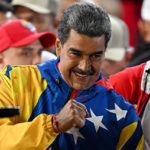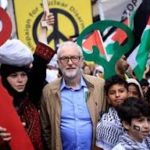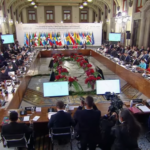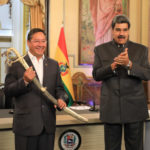In this election held in the middle of summer with a large part of the population on vacation, the main political forces created the conditions to limit the public debate. There was no discussion of the war in Ukraine or its economic and social consequences. The technical government of banker Mario Draghi held fast to Nato’s policy of rupture and sanctions against Russia – along with supporting Nato to arm Ukraine to the teeth and have it fight against Putin to the last consequences. The results would have certainly been different now in the context of an uncertain autumn, rampant inflation and hundreds of businesses near bankruptcy. The unfolding social unrest could have influenced the result. They got these elections through however, but never before has there been such a social distance between the Italian people and the political representation of the ballot box: only a little more than one Italian out of two went to vote.
Abstentions increased by 10% and turnout was only 63%. From 2018 to today, about 4 million people never voted out of the 51 million entitled. They do not think the vote is an instrument capable of changing their fate and that of the country. It is true that abstention mixes indifference and protest, but here, it expresses the view shared by an important part of the country that the political agenda is not determined by the coalitions that wins, but by the opinions of the European Commission and NATO-USA. The right-wing forces “won” this election, but with the same number of votes as in 2018. In not having reached 13 million, they did not suffice to knock out 5 Stars (5 Stelle) and the Democratic Party (PD – ex-Communist Party); all they did was to change the force relations between them. If Giorgia Meloni’s party (Frattelli di Italia, Brothers of Italy) came top, it is thanks to its “opposition” to the Draghi government and all those of the previous legislature. In just a few years, the Meloni’s party passed from 1.4 million votes (3.5%) to more than 7 million (26%)! It poached votes from its two allies, now paying the cost of their alliances with 5 Stelle, or PD. To find a result like this (of the rightwing today), you need to go back to 1968 when a unicolour Christian-Democratic government reached government with fewer than 13 million votes.

Results of the legislative elections 25.9.2022 in Italy.
Georgia Meloni cannot get off the rails of the European Union (EU) and NATO
The European Commission and the US government made their decision clear that they would use all means necessary to send a future Meloni government off “on good rails” – never mind how stoutly critical of the EU she had been in the past. This underlines the small margin of autonomy left to this “democratically elected” government. A simple look at European policy today shows how really close the Meloni government comes to it. Perfectly aligned with EU, NATO and US, even when in “opposition” to Draghi. The Meloni’s government’s alliance with the right-wing government in Poland, puts it in the main league of the shock forces against Russia. Apart from Italy, right-wing tendencies develop in other countries, although the most extreme are in Poland and Hungary. In countries like Spain, Sweden or France, they hover between 15-30%, with the rest of the political forces mitigating their votes.
The 5 Stelle movement passes from 10 million votes to just over 4 million. Its stemmed its hemorrhage thanks to its policy of the Redito de Ciudadanía (Basic Citizen Income). It adopted this measure in its first government (14.5.2018) when it made alliance with the League of Matteo Salvini (La Lega). Draghi and other parties wanted to eliminate this subsidy for the unemployed, but they failed. The lack of job prospects encourages many people to cling to this measure, notably in the south. They support 5 Stelle in order to defend it. To those who receive it, the Citizen Income gives the possibility to refuse the miserable wages of the bourgeoisie. The latter deplores that this subvention “prevents jobs from being taken up”, but in reality, it is the low wages paid in agriculture or tourism that prevent this.
The Democratic Party (PD) falls to its lowest historic level, and the center-left coalition loses more than a million votes. In the campaign, PD looked for its “left” pedigree now destroyed by years of PD governments in alliance with anybody loyal to the EU, to neo-liberal politics and to the NATO-US alliance. PD has been the main supporter of the Draghi government and its war on Russia. At the start of the electoral campaign, PD made an alliance with the party most supportive of former Goldman Sachs banker Azione. Time passing, it dropped Azione and its defence of the technical government (of Draghi) to start an alliance with some left-green force of no great pretensions. Upon which Letta – PD secretary – declared: “I will not govern with them”. The pro-Draghi Party drew some strength from the support of Matteo Renzi, former secretary to PD, the PD being now composed mostly of ex-Communist Party figures. The Centre-left Party with the pro-Draghi Party within it, lost support. Its vote of only 2 million underlines the electoral defeat of the “technical” government. This is on a one hand, and on the other, it concedes ground to the Meloni government, particularly if it (Centre-left) stays tied to the directives of the EU and Nato like Draghi did himself.
Those of the 5 Stelle profited from the favours of the “mainstream” press, but now the latter blames 5 Stelle for Draghi’s downfall. Giuseppe Conte is the political “leader” of 5 Stelle. He came to be called “the Italian Mélenchon” for having challenged Draghi with the following social program: Citizen Income, minimum wage at 9 euros per hour, windfall taxes on the multinationals’ extraordinary profits, no more arms to Ukraine, rejection of NATO’s intimation to increase Italy’s military expenditure. Perhaps those who attacked Conte’s program hoped to discredit him. In reality, they gave a leftist sheen to his movement. Conte presents himself as “progressist and not leftist” – and rightly so, considering how 5 Stelle’s movement reneged on all the progressive plans it had offered in 2018, the year when it won the elections. The most flagrant was when it surrendered to the Maastricht strictures, to high finance, and of Nato – the latter being the alliance 5-Stelle had vowed to cancel, along with all the F35 purchase contracts.
The right did not triumph, it just had no rival
Giorgia Meloni comes from the old fascist movement which changed composition several times over these last years. First with Gianfranco Fini and then with her. Of the original symbols, it only retains the tricolor flame, little or nothing to do with the culture and ideology of fascism. Her government is expected to be filled with old right-wing politicians who will be forced to adopt whatever policy gets dictated to them in due course. During the election campaign, Meloni made no commitments on the most pressing problems which she studiously avoided. She won’t be able to keep this up. It will not be enough to fend off NATO and the EU with generic formulas like “atlanticist solidarity”, “a European fund to face the energy crisis” or “for a common maximum ceiling in the price of gas”. All of this is bound to fail, particularly with countries like Germany openly dissociating. It is necessary for the State to re-appropriate the energy sector, and stop speculation on the purchase of gas. Top wealth mut be taxed. It is unfair that companies like the large food chains that made enormous profits should immediately raise their prices. Mass popular organs must be developed to control and denounce every speculation on price. The trade unions must be active in this matter.
For more than twenty years, “to go to government” in Italy has meant burning one’s hands. It happened with the Berlusconi’s Party, with 5 Stelle, with Salvini and with PD. Giorgia Meloni has no great political ability but she was rewarded for doing strictly nothing while Salvini squandered his electoral credit in an alliance with 5 Stelle. There is no way Meloni can face the coming problems, which is why she avoided them during the campaign. She will soon be discredited. The EU and NATO themselves are wary of her sudden pitch to Atlanticism and Europeanism. This is why they continue to pump her about her previous “fatal relationships” with the likes of Putin, Orban, Le Pen or the Polish rightwing.
Like never seen before in Italian history, Draghi nailed his government to the aggressive mast of Nato and its war on Russia. The times were when Italy would play pacifying roles, avoid direct participation in combats, look for services as in supplies or the formation of local troops. All the more so for the Italian Constitution imposing on the governments that, in any conflict, they should seek peaceful and diplomatic solutions. [But Draghi changed this course]. In the economic field, he followed to the letter the conditions imposed by the European Commission. The EU imposed that the €200 billion post-pandemic recovery grant, negotiated by the 5 Stelle when in government, had to be tied to so-called ‘reforms’. Those reforms do not deserve the name, because in the judiciary and other bodies, they grant to the multinationals access and control over public services and privatisations. The €200 billion are not directed towards what the masses need. They mostly go to the large private companies.
No investment is being directed to fill the deficit in the structures of public health found to be impotent during the pandemic. Nothing goes to the centres for education and formation that reject the young, force them to drop their studies or to flee the country. There are no plans to lend extraordinary support to the more than one million public workers. Nothing is planned to control enterprises, to stop the scandalous tax evasions (more than €200 billion), or the flagrant abuse of the workers forced into hundreds of different and precarious contracts of employment implemented in thousands of different forms. Some part-time contracts are actually full-time, overtime often added, but the pay is for the reduced hours with the rest possibly not declared! The workers of Italy are the lowest paid in Europe and subject to the most precarious contracts on the continent. Deaths at work reach the appalling number of 4 per day, entire regions having only one or two work-safety inspectors!
A left worthy of the name is missing in Italy
In the last elections, independent electoral lists for movements not likely to attract more than 3% support were cast aside. Since this occasion was a snap election, some lists did not have time to make themselves known. Fundamentally however, the social reasons for this are deeper. An independent left with a trade union and mass base needs time to become visible and set itself up. After the dissolution of the PCI (Italian Communist Party) in the wake of the fall of the USSR, we saw the start of a period of decline which now seems without end. A brief exception happened with Communist Refoundation but this ended with its participation in the Romano Prodi (PD) government. Add to this the decline of union and ‘political’ associationism, a decline that eventually reached the zones of protest in social centres or trade union bases. [..]
No major movements arose in Italy to make a mark on society in the way it happened in France or in Spain. France had mobilisations like the “Yellow Vests” or that of the CGT for retirement at 60. That slogan was retaken by a movement able to identify with it and acquire political authority, as with France Insoumise and Nupes.
In Spain, the “Indignados” originally stimulated by a youth movement acted as stimulant to the workers’ movement and the masses as a whole. This facilitated a political solution that gave Podemos and Izquierda Unida. Following the start of the Indignados, Podemos garnered one and a half million votes in three months flat, in the European Elections.
In Italy as elsewhere, such mass experiences did not happen, leading to continuous divisions and desertions. With great generosity Jean-Luc Mélenchon, Pablo Iglesias and Manon Aubry came to Italy during the campaign to support the Unione Popolare (UP) of Italy, which retook the Nupes’ name of Popular Union. No one had illusions about this being sufficient, but it attracted some attention in the media that had ignored it all before. Convened by Luis De Magistris, former mayor of Naples, Unione Popolare (UP) is an alliance between Communist Refoundation, Potere al Popolo, Manifest-A (parliamentary group expelled by the 5 Stelle) and several others[1]. Formed only on 9 July this year, UP did not have the time to win the confidence of a sector of vanguard workers. That vanguard has remained therefore concentrated in 5 Stelle under the pressure of the ghastly 3% electoral threshold.
The war of Nato, and its possible outcome, are whipping up a social upheaval that is sure to put the future leaderships of the left to the test. There will be no place for solutions of “national emergency”. During the pandemic, we saw how the upper classes, the big pharmaceutical companies (Big Pharma) and the other multinationals counted their profits, while the masses counted their dead.
The Meloni government will soon enter into crisis. A current represented by the Renzi-Calenda alliance[2] envisages already another possible ‘technical’ way out, with perhaps even Draghi joining in, to face up against the parties of the right. Enrico Letta of PD swears on all the saints that he will never repeat the error of supporting a technical government”[3]. But in spite of his past of Christian Democrat, nothing leads us to believe in such an oath.
The Posadists – October 10, 2022
The feature image shows demonstrators vowing not to pay for “the war of the rich” in Italy, “via the US/NATO bases on our land”. The occasion was in Niscemi, Sicily, on 10.9.22. The mention “No MUOS’ rejects the Mobile User Objective System installed in Niscemi in 2006 by the USA. This system is composed of 5 satellites and other amenities that provide, as officially reported, ‘connectivity and coordination to the US military around the globe’.
[1] The UP won between 375,000 and 403,000 votes for the Senate and parliament respectively, but no delegates.
[2] The political party of Matteo Renzi is Italia Viva, and that of Carlo Calenda is Azione.
[3] The technical government (or technocratic government) of Draghi in Italy was also called ‘governo tecnico’. This refers to an administration run by a cabinet of technocrats chosen to expedite current affairs in the absence of a properly elected administration. In November 2011, Belgium was led by caretaker technocrats and had been without government for 17 months.
.
















